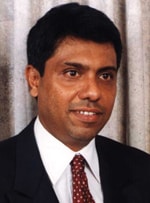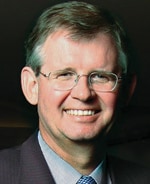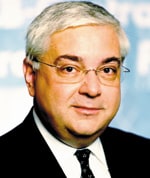The Way Forward in 2003
Bank CEOs and senior executives from among the winners of Global Finances Best and Safest Banks awards offer their views on the challenges and opportunities facing banks in 2003.

|
|
Ibrahim S. abdoub |
Top bank executives around the globe are cautiously optimistic that the world economy will begin to recover in the second half of this year as they continue to grow their businesses by meeting the demand for quality services from increasingly sophisticated clients.
After reporting satisfying results over the past 12 months, the banking leaders are optimistic about the fortunes that the new year holds for their companies, which are among the financial institutions named by Global Finance as Best Banks in 2002. Many of the bank executives are betting that the emerging-market nations, which frequently are not immersed in the same economic malaise as the large industrial nations, will continue to grow this year.
Consumers are the driving force behind the National Bank of Kuwaits growth, as the countrys favorable demographic and employment trends have produced stable growth in the domestic banking population, says Ibrahim S. Dabdoub, chief executive officer of that Gulf bank. And despite fears over what a war in that region would mean, politics isnt all bad news. Adds Amitha Gooneratne, chief executive officer of Commercial Bank of Ceylon in Sri Lanka, Even with pessimistic estimates of growth rates in the industrialized countries, the bank is optimistic about growth because of the progress being made in settlement of the countrys ethnic strife.
And at the bottom of the African continent, Standard Bank Group executives trust the banks diversified earnings stream will keep it financially healthy in the coming year. While the banks international operations have been hurt by the global slowdown, the bank is well positioned for a potential upswing in the world economy and doesnt anticipate an economic recession in South Africa this year, says Jacko Maree, chief executive officer of the South African bank. We expect to see solid growth in 2003 from our domestic and African operations. He adds that the South African economy is expected to grow an average of 3% to 3.2% for the next three to four years.

|
|
Amitha Gooneratne |
In Southeast Asia the Thai economy has been one of the regions strongest economic performers and is expected to expand by 3% to 4% this year. Given the brighter prospects, Bangkok Bank Public Company, as the largest Thai bank, is expected to benefit in terms of both credit growth and fee-based income, says Chartsiri Sophonpanich, bank president.
The Baltic countries are being helped economically by their pending integration into the European Union and their strategic geographic position between Europe and the former Soviet republics. We have witnessed a closing of the gap between the economies of the EU countries and those of the Baltics. We anticipate this growth being further stimulated by Latvias invitation to join NATO and its prospective entry into the EU in 2004, says Valery Kargin, president and chairman of the board at Parex Bank in Latvia. These factors will result in greater disposable income, growth in the real estate market and increased activity in the securities market, thus bringing rising demand for banking services.
And in the Western hemisphere, executives at Grupo Financiero BBVA Bancomer expect the Mexican economy to expand by 2.9% in 2003 if the nation remains financially stable and the United States begins its own long-awaited economic recovery. The Latin nation came out of a prolonged recession in the second quarter of 2002, and the subsequent economic revitalization helped increase employment and income levels, which in turn helped boost private sector bank financing.

|
|
Jacko Maree |
The banking industry in Mexico presents growth opportunities, resulting from the low penetration of banking services in the country and its highly transactional character, says Vitalino M. Nafria Aznar, director general of Grupo Financiero BBVA Bancomer in Mexico City.
Mauricio Samayoa, CEO at Banco Cuscatlan in El Salvador, is optimistic that the free trade agreementswhether within Central America or with external trading partners such as the United States, Canada and Chilewill give a boost to the Central American economies this year. While the global economic slowdown and US recession has hampered its activity, Banco Cuscatlan hasnt stopped pursing new opportunities in the region and plans to start operations in Panama during the first quarter of this year, he adds.
Consolidation
The expectations for merger and acquisition activity in the banking industry in 2003 vary widely from region to region and even country to country. Nafria at BBVA Bancomer, itself the product of a 2000 merger between Bancomer and BBV-Mexico, believes the consolidation process is over in Mexico. Three large banking groups now control 70% of the countrys banking market while six institutions control 90% of the banking industryand five of these institutions are majority-owned by foreign capital.

|
|
Chartsiri Sophonpanich |
Venezuela has undergone a similar trend of consolidation in the past three years that has left the four largest banks with more than 53% of the banking systems total assets. But link-ups may continue among smaller banks, according to Gustavo Marturet, chairman and chief executive officer of Banco Mercantil.
Yet at the southern end of the South American continent, the top executive at Banco Santander-Chile believes there is still room for consolidation even after the changes of the past five to six years. In 1995 Chiles top three banks had 30% of the combined loan market, and now their market share has nearly doubled to 57%, according to Mauricio Larrain, chairman of Banco Santander-Chile. Over the past 12 months the last two largest mergers created Chiles two largest banks: Banco Santander-Chile, with a market share of 25%, and Banco de Chile, with 19% of the market.
Although most analysts agree that there is room for niche players in the market, it will be difficult for them to compete head-on with the larger players given their higher efficiency levels, larger client base and distribution strengths, says Larrain.
In Slovenia a top banking executive believes merger and acquisition activity in his region will probably stagnate in the next few years as opportunities for niche banking increase. Cross-country mergers and acquisitions are not welcome in the developed countries, while most major acquisitions in emerging markets, such as Central and Eastern Europe, have already been executed, says Marko Volje, president and chief executive officer of Nova Ljubljanska Banka Group in Slovenia. There will be a possibility for an increased role and niche for specialized banks, both regarding product and customer focus in individual sectors. Volje was referring to sectors such as big corporate banking and private banking clients.

|
|
Gustavo Marturet |
Mixed Prospects for Asia
In Asia the top executive at the Commercial Bank of Ceylon believes the slow economy will translate into additional mergers and acquisitions. This type of consolidation will also help banks meet the demands of customers without stretching their capital resources to the limits, says Gooneratne. Despite this consolidation, there will still be room for banks specializing in niche markets, provided they can target the right segments with the right type of products and services.
Mergers and acquisitions will no doubt continue in Malaysia, as one of the key goals of Malaysian finance officials is improving the efficiency and effectiveness of the countrys financial institutions.
In 2000 and 2001 the countrys domestic banking sector consolidated into 10 domestic banking groups after the merger of 20 domestically controlled commercial banks, 22 finance companies and 12 merchant banks, according to figures provided by Public Bank, which has 382 branches spread around Malaysia. Consolidation is a key component of the financial sector master plan of Bank Negara Malaysia, the nations central bank, as a way for domestic banks to compete in the regional and global financial services market.

|
|
Valery Kargin |
As the process of liberalization of the Malaysian banking sector continues and in an increasingly competitive environment, it is expected that market forces will be the key to further consolidation and mergers in the Malaysian banking sector, says Tan Sri Dato Sri Dr. Teh Hong Piow, chairman and founder of Public Bank.
Banking officials in Thailand also see the possibility for additional mergers among the Southeast Asian nations 29 banksas well as opportunities for niche players. Banks which identify their strengths and are strongly focused on the market always have an opportunity to flourish, says Bangkok Banks Sophonpanich.
And the top executive at a leading European bank also believes that astute bankers will find their way. Fashions might change, but there will always be a future for both universal banks and niche players, as long as they are well positioned and efficient, says Walter Rothensteiner, chairman of the board of management at Raiffeisen Zentralbank Osterreich in Vienna. M&A; activities will continue to be a major force shaping the finance industryglobally, regionally and locally.

|
|
Mauricio Samayoa |
Customer Demand
A top priority for banks around the world is meeting the demand for quality services from increasingly sophisticated clients. Consumers are becoming more sophisticated and therefore have high expectations of their banks, says Sophonpanich of his Thai corporate and consumer customers. However, customer needs differ widely; therefore banks have to design their strategies to meet the requirements of each customer segment, he adds.
One way that the National Bank of Kuwait maintains the satisfaction of its customerswhether retail, private banking or corporateis by conducting regular surveys to identify customer perceptions and needs, says Dabdoub. The bank then refines its planning process to make sure its meeting those customers needs and expectations. We have been experiencing qualitative and quantitative growth in customer demand. Kuwaiti customers have faith in the stability and health of the banking system, adds Dabdoub. Consumers are currently the driver behind growth in our business and will continue to play this role in the coming year.
The Public Bank in Malaysia has seen customers become more demanding on a range of issues from pricing to product features to delivery. We have a proactive market-intelligence-gathering infrastructure, which includes regular feedback from branch managers and others on the ground, to ensure the group can speedily respond to changes in customer demand, the banks founder adds.
Parex Bank has placed a priority on investments in technology so the Latvian bank can meet the needs of its increasingly mobile and technologically advanced clients. In additional to advanced technology, todays client is concerned about the transparency and integrity of his bank, says Kargin. We feel that Parex Banks success in this has been a significant contributing factor in expanding our customer base and attaining another year of nearly 40% growth in deposits.

|
|
Vitalino M. Nafria Aznar |
Customers at the Commercial Bank of Ceylon increasingly want secure and inexpensive methods of money transmissions as well as convenient ways to access their accounts. And referring to corporate customers, Gooneratne adds that banks are routinely required to have a global reach through strong correspondent and a branch network.
Since products and prices can be emulated quite easily, customer service is the key differentiator in South African banking for both corporate and retail customers. The retail bank constantly measures its service levels using both internal and external surveys and aims to meet targets set every year, Standard Banks Maree says. On the corporate and commercial side, much emphasis is placed on relationship-building and service.
E-banking
Whether its Southeast Asia, the Middle East or Latin America, e-banking continues to prove popular with corporate and retail banking clients around the world even if the rates of growth are expected to slow in the coming year.
At Banco Mercantile in Venezuela, Internet-based banking is a new customer service channel that has grown tremendously over the past several years. Banco Mercantil has 220,000 clients using e-banking on a regular basis, and 22% of the banks transactions are completed through distribution channels executed by the Internet, says Marturet. E-banking will continue to grow in the coming years, but at a slower pace.

|
|
Teh Hong Piow |
E-banking also has developed rapidly in Chile. At Banco Santander-Chile the number of online customers has grown more than 65% a year. The greater use of computers and expansion in computer processing capacity will keep boosting the use of e-banking at the retail level, bank executives say. And at the corporate level the electronic banking business will grow with e-banking services designed specifically for each client.
The bank will seek to become its clients main bank by means of Internetizing the client-bank relationship as well as the relationship between clients and their suppliers, distributors and customers, says Larrain.
The National Bank of Kuwait, an early backer of the Internet as a delivery channel, focuses on using the Web to cross-sell and market services to targeted groups of customers as well as to introduce new customer solutions. Using strategic information in our data warehouse and the latest CRM tools, we are able to personalize and customize services, says Dabdoub. Our goal is for customers to be able to do all their banking online.
At the Commercial Bank of Ceylon retail customers extensively use e-banking for routine but time-consuming transactions. Our bank continues to invest in hardware and software, facilitating a wider type of e-banking applications, says Gooneratne. We are doing so because we are optimistic of the rising popularity of e-banking.
And in Europe RZB has seen a rapid growth in the use of its e-banking products among retail clients. The banks executives expect growth will continue for another two years in Austria, when the market will reach saturation, while the Central and Eastern European markets will keep growing. Bricks will continue to be as important as clicks, as customers demand to address bankers personally, especially if there is something to complain about, says Rothensteiner.

|
|
Walter Rothensteiner |
And even though the majority of Czech customers still prefer to visit their branch, bank executives believe the shift toward greater use of e-banking will gradually occur. It is noticeable, especially in the case of younger or company clients, who prefer Internet banking or GSM or phone banking, says Pavel Kavanek, chief executive officer of Ceskslovensk obchodn banka in the Czech Republic. Banks are trying to motivate their clients to use Internet banking by offering advantageous prices. They are able to implement this pricing policy because the operations costs related to Internet banking are, as opposed to the initial start-up costs, relatively low.
Capital Markets.
Bankers from Latvia to El Salvador are cautiously optimistic that the equity and bond markets may offer their clients more opportunity in the coming year.
In Southeast Asia, Malaysian capital markets will be active and undergoing structural changes this year as the government continues to implement the Malaysian capital markets master plan. Another major development is the proposed demutualization of the Kuala Lumpur Stock Exchange. And bank executives at Public Bank also expect to see increased activity in the domestic bond market, particularly in the issuance of Islamic bonds.
Executives at Parex Bank think 2003 could be a more active year than last with the rapid consolidation of the Baltic and Nordic equity markets. And more investors in Slovenia are putting their funds into the stock market as some of the largest Slovenian public companies have been acquisition targets.
Meanwhile, in Central America customers demands for new and innovative products means the regions capital markets should grow in 2003, according to Banco Cuscatlans Samayoa.
In the Middle East Kuwaits capital markets have been very active and performed well over the past two years with attractive dividend yields. The issue is not whether [stock and bond markets] will be open, but what sort of returns [clients] should expect and over what time horizon, says Dabdoub. For the United States and Europe, calling the market bottom is a wild call at the present time, given the uncertainties and geopolitical risks we are facing. But for an investor with a long-term horizon, there are certainly attractive names, though potential returns will be nowhere near 1990s levels.
Paula L. Green



